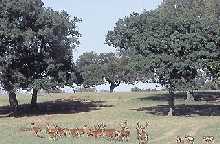| |
Bovine tuberculosis endemic in british wildlife
 |
 Picture: © Bayer Animal Health Picture: © Bayer Animal Health
|
 |
This is the result of a newly published report: it confirmed that bovine tuberculosis (TB) has spread further into wildlife populations than was
previously thought, especially to the yellow-necked mouse, wood mouse, shrew, polecat, muntjac and stoat. And it also showed that deers are extremely vulnerable to bovine TB - up to 16% of them were tested positive.
|
 |
 |
|  |
The report entitled `The Risk To Cattle From Wildlife Species Other Than Badgers In Areas Of High Herd Breakdown Risk` was published on 9 July 2004.
Carried out by the Central Science Laboratory, the study revealed that `deer could pose a significant risk` of spreading bovine TB to cattle and that other wildlife species were infected.
The CSL`s 4-year study in 7 English counties is the largest systematic survey for Mykobacterium bovis ever carried out in the UK.
It involved investigating nearly 5000 carcasses and, while prevalence of the disease was greater in badgers, risks posed by deer should no longer be overlooked, it stated.
The report estimated the UK deer population -- including farmed deer -- to be between 1.25 million and 2.6 million, compared with about 300 000 badgers. Between 1 and 15 percent (12 500-390 000) of the deer could be infected with bovine TB.
While 4.4 percent of the 504 fallow deer tested displayed symptoms, 16 percent of whole carcasses available tested positive.
The report also noted that deer were particularly vulnerable to bovine TB and often shared pasture, feed and water troughs with cattle.
The National Federation of Badger Groups` chief executive Elaine King said it was strange the report had been posted on the DEFRA website late with no press release or briefing.
`It`s now quite clear that bovine TB is endemic in wildlife across the UK,` said Dr King.
Source: www.promedmail.org
Tell a friend
|
Print version
|
Send this article
|
|  |

Immune modulators and proliferation of peripheral blood mononuclear cells in cows peripartum Milk/plasma ratio and milk and plasma pharmacokinetics of amoxicillin in lactating cows Milk/plasma ratio and milk and plasma pharmacokinetics of amoxicillin in lactating cows Neuromuscular block monitoring after cis-Âatracurium in the anaesthetized pig Neuromuscular block monitoring after cis-Âatracurium in the anaesthetized pig Growth factor expression in cows with cystic ovarian disease Growth factor expression in cows with cystic ovarian disease Protecting protein to reduce methane production in ruminants Protecting protein to reduce methane production in ruminants Lifetime prognosis in cattle with necrotic laryngitis Lifetime prognosis in cattle with necrotic laryngitis ECG findings in neonatal calves with diarrhea and associated potassium balance disorders ECG findings in neonatal calves with diarrhea and associated potassium balance disorders Bacterial translocation in calves with atresia coli Bacterial translocation in calves with atresia coli Optimising lameness detection in dairy cattle Optimising lameness detection in dairy cattle  Role of melatonin and its receptors in animal reproduction Role of melatonin and its receptors in animal reproduction Physiological changes in inflammatory parameters in cows prae and post partum Physiological changes in inflammatory parameters in cows prae and post partum Zinc Deficiency-Like Syndrome in Fleckvieh Calves Zinc Deficiency-Like Syndrome in Fleckvieh Calves
|















